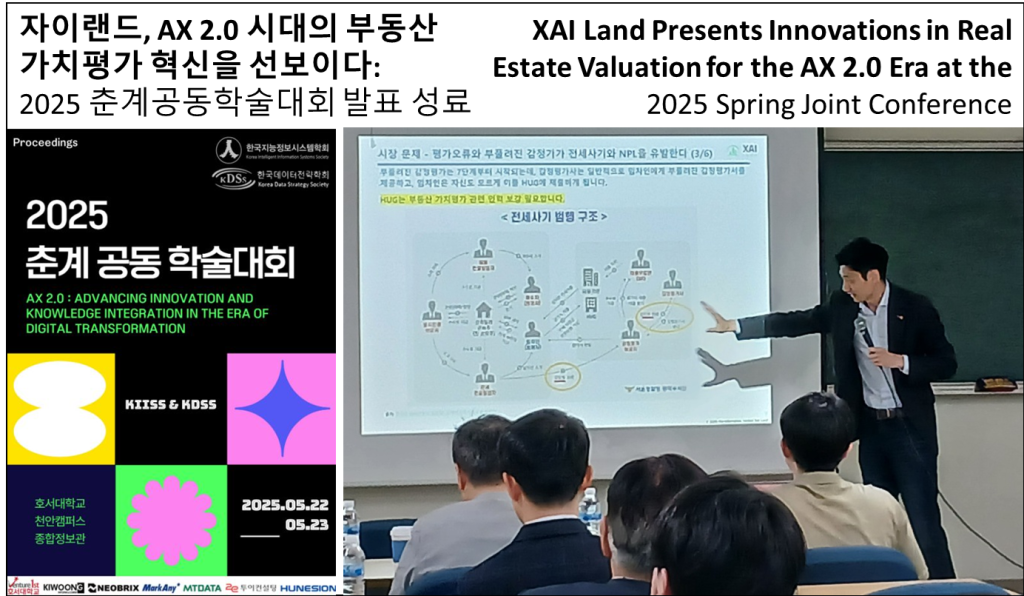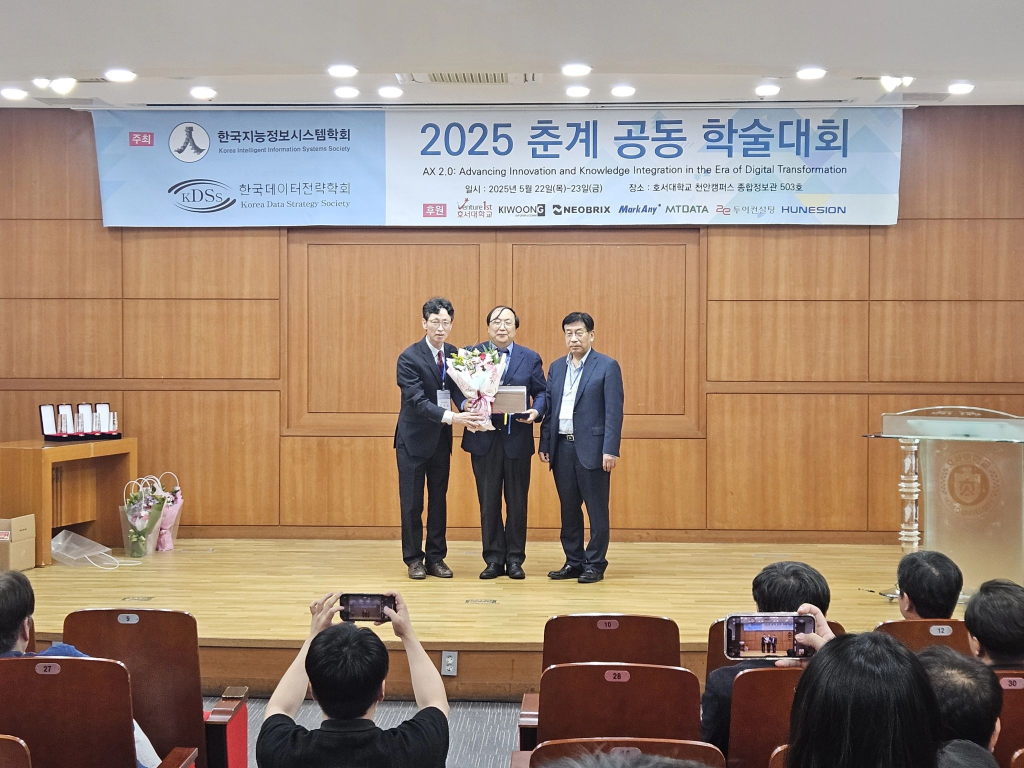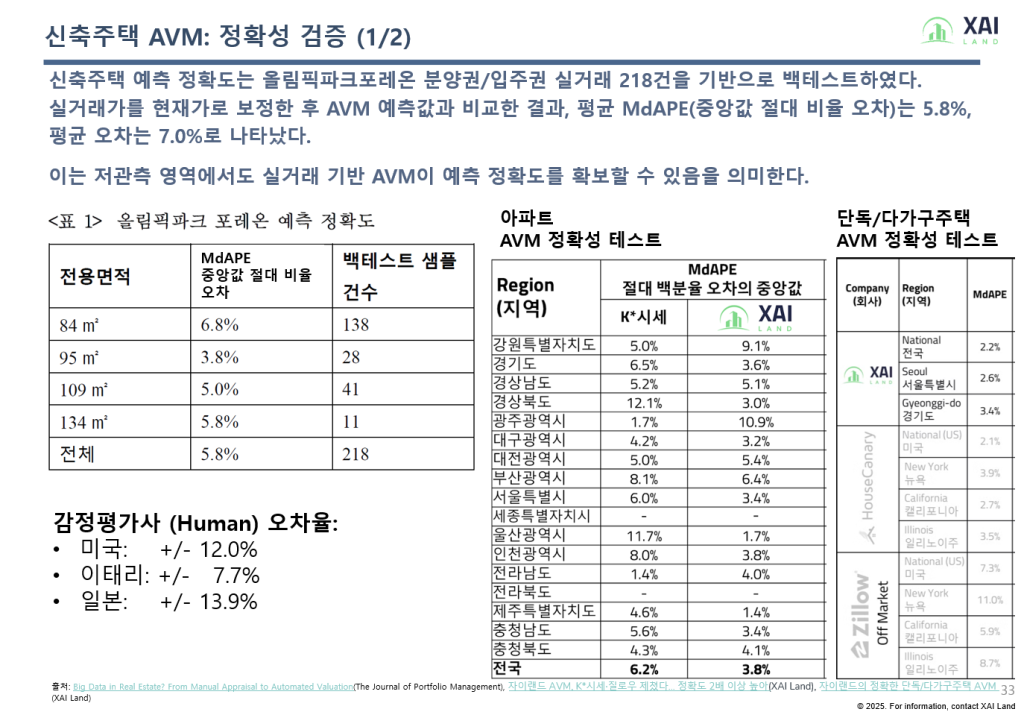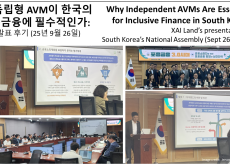자이랜드, AX 2.0 시대의 부동산 가치평가 혁신을 선보이다: 2025 춘계공동학술대회 발표 성료


< English follows Korean >
지난 5월 23일, 자이랜드(XAI Land)는 한국지능정보시스템학회(Korea Intelligent Information Systems Society, KIISS)와 한국데이터전략학회(Korea Data Strategy Society, KDSS)가 공동으로 주최한 2025 춘계학술대회에 참가하여 “AX 2.0: 디지털 전환 시대의 혁신과 지식 통합의 발전”이라는 주제 아래 자동가치산정모형(AVM)의 미래에 대한 심도 있는 발표를 진행했습니다.

이번 학술대회에서 자이랜드의 임동준(Raymond Chetti) 대표는 “자동가치산정모형(AVM)의 정확성과 투명성 제고, 그리고 신축 주택을 위한 AVM 개발: 자이랜드의 접근법과 향후 AVM 도입에 대한 시사점”이라는 주제로 발표하며 관계자들의 큰 주목을 받았습니다.
대한민국 부동산 가치평가의 현주소와 과제
자이랜드는 현재 한국 부동산 가치평가 시스템이 안고 있는 다양한 문제점을 지적했습니다. 인간의 주관적 판단에 크게 의존하는 기존 감정평가 방식은 투명성 부족과 이해관계 충돌 문제로 인해 종종 부정확한 평가로 이어지며, 이는 금융기관의 부실채권(NPL) 위험 증가, 전세 사기 발생, 국민의 주거 불안정 및 정부와 금융 시스템에 대한 신뢰 하락 등 심각한 사회경제적 문제들을 야기하고 있습니다.
특히, K*시세와 같은 기존 시장 가격 정보의 제한적인 적용 범위와 정확성 논란, 정부 통계에 대한 불신 등은 오랫동안 지적되어 온 문제입니다. 이러한 배경 속에서 객관적이고 신뢰할 수 있는 AVM의 중요성은 더욱 커지고 있습니다.
자이랜드 AVM: 정확성, 투명성, 그리고 신뢰를 향한 혁신
자이랜드는 이번 발표를 통해 자사가 개발한 고정확성 AVM 시스템과 그 핵심 기술을 소개했습니다. 자이랜드의 AVM은 Google Cloud Platform을 기반으로 구축되었으며, Gradient Boosting 기반의 앙상블 모델을 채택하고 부동산 유형별 하위 모델을 적용하여 정밀도를 높였습니다.

특히, 기존 AVM이 다루기 어려웠던 신축 주택 가치 산정 문제 해결을 위한 자이랜드만의 기술적 접근법과 올림픽파크포레온 분양권/입주권 실거래 데이터를 활용한 백테스팅 결과(MdAPE 5.8%)를 공개하며 기술적 우위를 선보였습니다. 이는 정보가 부족한 신축 부동산 영역에서도 AVM이 신뢰할 만한 가치를 제공할 수 있음을 시사합니다.
자이랜드는 단순한 기술 시연을 넘어, AVM의 사회적 수용성 확대를 위해 필수적인 ‘투명성 관리 방안’을 강조했습니다. 이는 모델의 정확도 지표(MdAPE, PPE@10% 등) 공개, 그리고 향후 도입될 SHAP(SHapley Additive exPlanations) 등을 통한 설명가능성 확보 노력을 포함합니다. 또한, Supabase 기반의 감사 추적 기능은 데이터 및 평가 과정의 신뢰도를 높이는 핵심 요소입니다.
금융기관 및 정부를 위한 AVM의 역할과 미래
자이랜드는 AVM이 주택시장 안정과 금융 리스크 완화에 기여할 수 있는 잠재력을 강조하며, 특히 금융기관과 정부의 실질적인 문제 해결에 기여할 수 있는 방안을 제시했습니다.
- 금융기관: 담보대출 심사 시 부실대출(NPL) 리스크 감소, 감정 프로세스 자동화를 통한 효율성 증대, 업감정(부풀려진 감정평가)으로 인한 전세사기 예방 등에 AVM을 활용할 수 있습니다. 자이랜드의 AVM은 자체 백테스트 및 금융기관 대상 분석 자료를 통해, K*시세 대비 예측 오차가 낮고 실제 회수 가치를 보다 정밀하게 반영할 수 있음을 보여주고 있습니다.
- 정부 및 공공기관: 공공주택 매입 시 고가매입 방지를 통한 예산 절감 및 더 많은 주택 공급 실현, 공시가격 산정의 정확성 및 효율성 제고, 그리고 2026년 시행 예정인 ‘AI 기본법’이 요구하는 설명가능성, 감사 이력, 신뢰성 확보 요건 충족에 AVM이 핵심적인 역할을 할 수 있습니다.
심도 있는 논의: 학술대회 주요 질의응답 및 자이랜드의 답변
자이랜드의 발표 이후, 주요 참석자들로부터 부동산 AVM의 현실적인 적용과 관련된 심도 있는 질문들이 이어졌습니다. 자이랜드는 이러한 질문들이 AVM 기술의 발전과 사회적 수용에 매우 중요하다고 생각하며, 주요 질의와 그에 대한 자이랜드의 견해를 공유하고자 합니다.
질문 1: 부동산의 동적 가격 추정은 AI 모델을 사용하더라도 매우 어려울 수 있습니다. 추정치의 오차 허용 범위는 어느 정도이며, 불가피하게 발생할 수 있는 오차에 대한 책임은 누가 져야 합니까? 자이랜드의 모델은 투자 모델만큼 정확해야 합니까?
자이랜드의 답변: AVM은 섀로 표준값을 보유할 수 밖에 없는 힘들고 보안된 값과 설명가능성을 가진 것이 중요합니다. 자이랜드는 경우에 따라 어느 내용까지 각 기관이 결정할 수 있도록 ‘오차 값’ 과 ‘신뢰도 검토’를 각 AVM 값에 포함하고 있습니다.
오차 허용 수준 및 관리:
- 국내 기준 : 2022년 개정된 「감정평가 실무기준(제2022-653호)」은 AVM을 “보조 도구”로 인정하며, AVM 결과 사용 시 책임은 이를 활용하는 기관(금융사, 공공기관 등)에 있습니다.
- 국제 사례 : 미국 Freddie Mac, Fannie Mae는 MdAPE(중앙값 절대 비율 오차) 10% 미만 AVM을 ‘데스크 감정’에 허용하고 ‘신뢰도 지표(Confidence Score)’를 필수로 제시합니다. 영국 VOA(Valuation Office Agency)는 무작위 감사를 통해 오차 범위를 모니터링합니다.
- 자이랜드 구현: 자이랜드는 지역별, 주택 유형별 MdAPE(중앙값 절대 비율 오차)와 같은 성능 지표를 투명하게 공개하여 사용자가 오차 수준을 인지할 수 있도록 합니다. 해외 연구에 감정평가사는 약 7~14%의 오류율을 보이는 반면, 저희 AVM은 중앙값 2~5%의 절대 오류를 보였기 때문에 현재 저희 모델은 인간의 벤치마크보다 더 정확한 성능을 발휘하고 있습니다. 더 나아가, 저희는 예측치의 신뢰도를 A부터 D까지 등급화하는 시스템을 개발 중입니다. 이 신뢰도 등급은 특정 예측에 수반되는 불확실성 수준을 명확히 하여, 사용기관(은행, 공공기관 등)이 자체적인 위험 관리 기준과 허용 오차 범위 내에서 AVM 결과를 활용한 의사결정을 내릴 수 있도록 지원합니다.
오차 책임 분담(Responsibility):
- 국내 규정 : “감정평가 실무기준 2022”에 따르면, AVM이 생성한 값은 ‘보조 결과’이며, 최종 감정 책임은 이를 사용하는 감정평가사 또는 기관에 있습니다.
- AI기본법(2026년 시행) : 고위험 AI(AVM 포함)는 설명가능성(Explainability)과 감사추적성(Auditability)을 법적으로 확보해야 합니다. 자이랜드는 SHAP 기반 설명 기능과 Supabase 기반 로그 체계를 도입하여, AVM 예측 과정을 완전 투명하게 관리합니다.
- 투자 모델과의 정확성 비교: 자이랜드의 AVM은 주로 주택담보대출 심사, 포트폴리오 평가, 공공 목적의 자산 평가 등 광범위한 적용을 목표로 하며, 해당 목적에 충분한 높은 정확성을 추구합니다. 투자 모델은 특정 투자 전략과 수익률 극대화에 초점을 맞추므로 요구되는 변수나 민감도가 다를 수 있습니다. 자이랜드 AVM은 특정 투자 수익률 예측보다는, 현재 시장 상황을 반영한 공정하고 신뢰할 수 있는 가치 추정에 중점을 둡니다.
질문 2: 과소평가와 과대평가 중 어떤 위험이 더 해롭습니까? 예를 들어, 공시지가가 낮으면 심각한 불만이 없지만, 실거래가를 초과하면 납세자들로부터 심각한 민원이 발생할 수 있습니다. 오차의 이해관계자는 누구입니까? 정부는 책임이 커질 경우 모델 채택에 신중할 수 있습니다.
자이랜드의 답변: 과소평가와 과대평가 모두 부정적인 결과를 초래할 수 있지만, 그 영향은 상황과 이해관계자에 따라 다르게 나타납니다.
- 위험의 성격:
- 과대평가: 금융기관의 경우 담보가치 과대평가는 부실대출(NPL) 증가 및 대출 회수 실패 위험을 높이고, 전세 시장에서는 전세사기의 빌미를 제공하여 세입자에게 막대한 피해를 줄 수 있습니다. 공공기관이 자산을 고가에 매입하게 되면 예산 낭비로 이어집니다. 저희 분석에 따르면 KB시세는 특정 지역에서 자이랜드 AVM보다 현저히 높은 빈도로 과대평가되는 경향이 있었습니다.
- 과소평가: 공시지가의 경우, 과소평가는 세수 감소로 이어질 수 있지만, 주택 소유자의 경우 대출 한도 축소나 재산 가치 저평가로 인한 불이익을 겪을 수 있습니다. 복지 수급 자격 심사 등에서도 불합리한 결과를 초래할 수 있습니다.
- 수만 건의 현지 거래를 분석하고 알고리즘을 실시간으로 동적으로 업데이트함으로써 자이랜드의 AVM은 과대평가 실행을 약 50~75%(기존 지표 대비) 줄이고 신뢰도가 낮은 영역에 플래그를 지정하여 과소평가로 이어지는 사각지대를 방지합니다.
- 전 세계적으로 규제 당국은 과대 추정이 즉각적으로 더 큰 손실을 초래하는 경우가 많고, 과소 추정은 수익에 영향을 미치지만 표면화되는 속도가 느리다는 사실을 알게 되었습니다. 저희는 최적의 균형을 맞추기 위해 AVM을 구축합니다.
오차의 이해관계자: 부동산 가치평가 오차의 이해관계자는 광범위합니다. 금융기관, 정부(중앙 및 지방), 감정평가사, 주택 구매자 및 판매자, 임차인, 납세자 모두가 직간접적인 영향을 받습니다.
정부의 모델 채택: 정부가 AVM 도입에 신중한 것은 당연하며, 이것이 자이랜드가 투명성, 정확성 검증, 감사추적성, 설명가능성을 강조하는 이유입니다. 신뢰할 수 있는 AVM은 오히려 정부가 정책 결정의 객관성과 공정성을 높이고, 예산을 효율적으로 사용하며, 국민 신뢰를 회복하는 데 기여할 수 있습니다. AI기본법의 기준을 충족하는 AVM을 활용하면, 정부는 예측 불가능성에서 오는 책임을 줄이고, 데이터 기반의 일관된 시스템 운영으로 책임 소재를 보다 명확히 할 수 있습니다.
질문 3: 모델이 공인 감정평가사의 역할을 대체할 경우, 그들과의 이해상충 문제는 무엇입니까? 자이랜드의 모델은 그들을 지원합니까, 아니면 경쟁합니까?
자이랜드의 답변: 자이랜드 AVM은 공인 감정평가사를 대체하기보다는 보완하고 지원하는 역할을 목표로 합니다. 저희는 감정평가 시장의 효율성과 신뢰성을 전반적으로 향상시키는 데 기여하고자 합니다.
- 이해상충 및 협력 가능성:
- 기존 감정평가 시스템은 평가사의 주관 개입 가능성, 이해관계 충돌 우려 등의 문제가 지적되어 왔습니다. AVM은 이러한 부분에서 객관적이고 일관된 기준을 제공하여 평가의 신뢰도를 높이는 데 도움을 줄 수 있습니다.
- 자이랜드 AVM은 감정평가사분들이 참고할 수 있는 빠르고 신뢰도 높은 기초자료를 제공하거나, 대량 평가 업무(예: 과세 목적의 대량 감정, 금융기관 포트폴리오 정기 평가)에서 효율성을 극대화하는 도구로 활용될 수 있습니다.
- 복잡하거나 비정형적인 부동산, 법적 분쟁이 있는 경우 등 전문적인 판단과 현장 실사가 필수적인 영역에서는 여전히 감정평가사의 역할이 중요하며, AVM은 이러한 고부가가치 업무에 집중할 수 있도록 지원할 수 있습니다.
- 지원 모델: 저희는 AVM을 “모든 시장 참여자를 위한 신뢰의 인프라”로 보고 있습니다. 감정평가사분들도 이 인프라의 중요한 사용자이자 파트너가 될 수 있다고 믿습니다. 예를 들어, 감정평가 법인이 저희 AVM을 내부 검토 자료로 활용하거나, 저희 데이터를 기반으로 더욱 정교한 분석 보고서를 작성하는 등의 협력 모델을 구상할 수 있습니다. 자이랜드는 감정평가 업계와의 소통을 통해 상호 발전적인 관계를 구축하고자 합니다.
미래를 향한 제언
자이랜드는 AVM이 단순한 기술 도구를 넘어 공정한 가치 정보를 제공하는 사회적 인프라로 자리매김하기 위해서는 정책적, 제도적 개선이 필수적이라고 강조했습니다. AVM 성능에 대한 독립적 제3자 평가 기준 정립, 설명가능성 및 예측 신뢰도 등급화 결과의 정기적 공개 의무화, 그리고 AVM 운영의 이해상충 방지를 위한 법적·제도적 장치 마련 등이 시급한 과제입니다.
자이랜드는 앞으로도 기술 고도화와 더불어 정책 포럼 참여 등을 통해 한국의 AVM 도입과 시장 확대를 위한 노력을 지속할 것입니다. 금융 및 공공기관 관계자 여러분의 많은 관심과 협력을 기대합니다.
자이랜드(주)에 대하여
자이랜드는 한국인이 어디에 있든 사기, 불공정 관행, 과다 청구의 위험 없이 완전한 투명성을 바탕으로 안심하고 부동산 금융과 거래를 할 수 있는 세상을 꿈꿉니다.
가장 정확한 자동가치산정모형(AVM)을 통해 부동산 거래를 지원하며, 정확한 가치 평가와 투명한 거래 프로세스를 보장하는 것이 우리의 사명입니다. 우리는 부동산 사기를 예방하고 공정한 가격을 보호하며, 국내외 모든 부동산 관련 과정에서 원활하고 안전한 경험을 제공하기 위해 끊임없이 노력하고 있습니다.
더 자세한 내용을 원한다면, https://xai.land/ 를 방문하거나 LinkedIn ( https://www.linkedin.com/company/18522292/ ) 또는 Facebook ( https://www.facebook.com/xailand/ )의 업데이트를 팔로우하십시오.
주요 요약은 Linktree(https://linktr.ee/xai_land)에서도 한눈에 확인하실 수 있습니다.
XAI Land Presents Innovations in Real Estate Valuation for the AX 2.0 Era at the 2025 Spring Joint Conference
This past May 23, XAI Land participated in the 2025 Spring Joint Conference, co-hosted by the Korea Intelligent Information Systems Society and the Korea Data Strategy Society. Under the conference theme “AX 2.0: Advancing Innovation and Knowledge Integration in the Era of Digital Transformation,” XAI Land delivered an insightful presentation on the future of Automated Valuation Models (AVMs).
At the conference, XAI Land’s CEO, Raymond Chetti, garnered attention with his presentation titled, “Enhancing Accuracy and Transparency of Automated Valuation Models (AVM), and Development of AVM for New Construction Homes: XAI Land’s Approach and Implications for Future AVM Adoption.”
The Current State and Challenges of Real Estate Valuation in South Korea
XAI Land highlighted various issues plaguing South Korea’s current real estate valuation system. The conventional appraisal methods, heavily reliant on subjective human judgment, often lead to inaccurate valuations due to a lack of transparency and conflicts of interest. This, in turn, contributes to serious socio-economic problems such as increased risk of non-performing loans (NPLs) for financial institutions, Jeonse fraud, housing instability for citizens, and a decline in public trust in governmental and financial systems.
In particular, controversies surrounding the limited coverage and accuracy of existing market price information like KB and distrust in government statistics, have been long-standing concerns. Against this backdrop, the importance of objective and reliable AVMs is growing.
XAI Land AVM: Innovation Towards Accuracy, Transparency, and Trust
In its presentation, XAI Land introduced its high-accuracy AVM system and its core technologies. XAI Land’s AVM is built on the Google Cloud Platform, employing gradient boosting-based ensemble models and applying sub-models tailored to specific property types to enhance precision.
Notably, XAI Land showcased its technological edge by sharing its unique approach to valuing new construction homes—a challenge for existing AVMs—and by disclosing backtesting results (MdAPE of 5.8%) using actual transaction data for pre-sale/occupancy rights of Olympic Park Foreon. This suggests that AVMs can provide reliable valuations even in the data-scarce new construction sector.
Beyond a mere technological demonstration, XAI Land emphasized its “transparency management plan,” which is crucial for the broader societal acceptance of AVMs. This includes the disclosure of model accuracy metrics (e.g., MdAPE, PPE@10%) and efforts to ensure explainability through the future adoption of SHAP (SHapley Additive exPlanations). Furthermore, the Supabase-based audit trail capability is a key element in enhancing the reliability of data and the valuation process.
The Role and Future of AVMs for Financial Institutions and Government
XAI Land stressed the potential of AVMs to contribute to housing market stability and financial risk mitigation, presenting ways they can help solve tangible problems for financial institutions and the government.
- For Financial Institutions: AVMs can be utilized to reduce NPL risks in mortgage underwriting, increase efficiency through automated appraisal processes, and prevent jeonse fraud caused by inflated appraisals. XAI Land’s AVM has already demonstrated lower error rates and accuracy reflecting actual recovery rates compared to KB Sise in case studies of two different financial institutions.
- For Government and Public Agencies: AVMs can help prevent overpayment in public housing acquisitions, thereby saving budgets and enabling more housing supply; improve the accuracy and efficiency of official price calculations for taxation; and play a key role in meeting the requirements for explainability, audit trails, and reliability mandated by the ‘AI Basic Law’ scheduled to take effect in 2026.
Engaging in Deeper Discussion: Key Q&A from the Conference and XAI Land’s Responses
Following XAI Land’s presentation, insightful questions were raised by key attendees from the financial and public sectors regarding the practical application of Automated Valuation Models (AVMs). XAI Land believes these inquiries are vital for the advancement and societal acceptance of AVM technology and wishes to share its in-depth perspectives, reflecting global best practices and the domestic regulatory environment.
Question 1: My rough thought is that the estimation of dynamic price of real estate may be very difficult even though you may adopt AI Models. I am concerned about what would be the tolerance of errors in estimation, and who should take the responsibility of the errors which may be unavoidable? Should your model be as accurate as the Investment Model?
XAI Land’s Response:
We deeply acknowledge the dynamic nature of real estate prices and the inherent challenges in their estimation; this is a core challenge in AVM development. XAI Land addresses this by focusing on accuracy, transparency, and user-centric risk management support.
- Error Tolerance and Management:
- Korean Standards : The 2022 revision of the Appraisal Practice Standard (No. 2022-653) recognizes AVM as an “auxiliary tool,” and the responsibility for using AVM results rests with the institution (financial institution, public institution, etc.) that utilizes it.
- Global Standards: In the U.S., Freddie Mac and Fannie Mae accept AVMs for desktop appraisals, typically applying error thresholds of MdAPE <10% and requiring confidence scores to flag riskier estimates. The UK’s VOA (Valuation Office Agency) uses AVMs for mass valuations, managing risks through random audit sampling and disclosure of confidence levels.
- XAI Land’s Approach: Referencing these international precedents, we transparently disclose performance metrics like MdAPE for different regions and property types. Independent studies report typical human appraisal errors around 7–14%. Our own backtests show median absolute errors in the 2–5% range for standard housing types. Furthermore, we are developing a system to grade the reliability of our predictions from A to D. This confidence grade will clarify the level of uncertainty accompanying a specific prediction, supporting user institutions (banks, public agencies, etc.) in making decisions based on AVM results within their own risk management frameworks and error tolerance levels.
- Responsibility for Errors: An AVM is a powerful decision support tool, and liability should be considered multi-dimensionally.
- Domestic & International Trends: South Korea’s “Standard for Real Estate Appraisal Practice (2022)” allows limited AVM use (e.g., for non-apartment appraisal reports) but specifies that responsibility for using the results lies with the user institution, not the AVM provider. U.S. court precedents also generally place liability with the financial institution, unless there is clear negligence or misrepresentation by the AVM provider.
- Role of AI Regulation: The EU AI Act and South Korea’s upcoming AI Basic Law (effective 2026) will impose obligations on developers of high-risk AI systems like AVMs to ensure explainability and traceability. However, this doesn’t imply sole liability for all errors. The key is to ensure the system is not grossly misleading and lacks no transparency.
- XAI Land’s Contribution: We are preparing to provide explainability through SHAP analysis and enhance auditability using Supabase. This empowers users to make rational, informed decisions and clearly understand the basis for those decisions. This fosters a “shared responsibility” model where XAI Land provides robust tools, and users make the final judgment.
- Accuracy Compared to Investment Models: XAI Land’s AVM aims for high accuracy suitable for broad applications like mortgage underwriting, portfolio valuation, and public asset assessment. This differs in purpose and scope from investment models focused on predicting future returns for specific investment strategies. XAI Land focuses on providing the most fair and reliable estimation of current market value.
Question 2: Which risk is more damaging: underestimation and overestimation? For instance, if 공시지가 (officially declared price) is lower, there is no serious complaints. But if it exceeds the real price, it will cause serious claims from tax payers. Who are the stakeholder(s) of the errors: your company, government, buyer and seller? Government may be cautious in accepting a model if their responsibility increases.
XAI Land’s Response:
Both underestimation and overestimation have detrimental effects, though the nature of the risk differs depending on the valuation’s purpose and the stakeholders involved.
- Nature of Risk:
- Risks of Overestimation: In South Korea, overvaluations by appraisers and entities like KB contributed to MG Community Credit Cooperatives’ NPLs from Jeonse fraud-related loans and were a factor in HUG’s (Housing & Urban Guarantee Corporation) over ₩4 trillion deposit guarantee incidents. This led to substantial financial losses and social unrest. As seen in the 2008 U.S. crisis, collateral overvaluation became a systemic risk—an experience that informs Korean regulators’ caution today. XAI Land’s backtesting has shown its AVM can significantly reduce the frequency of overvaluation compared to existing market price information.
- Risks of Underestimation: For officially declared prices (공시지가), underestimation might face less immediate political backlash from taxpayers but can erode the national tax base over time and distort the fairness of welfare systems. For example, if property asset values are underestimated, it can affect eligibility for welfare programs where asset-to-income ratios are critical. In Japan, conservative AVMs used for fixed asset tax valuation faced public challenge, leading to a system overhaul in 2022.
- By analyzing tens of thousands of local transactions and dynamically updating our algorithms in real-time, XAI Land’s AVM reduces overvaluation runs by approximately 50~75% (versus legacy indices) and flags low-confidence zones to avoid blind spots that lead to under-estimation.
- Globally, regulators have learned that overestimation often inflicts greater immediate losses; underestimation affects revenue but is slower to surface. We build our AVM to strike the optimal balance.
- Stakeholders of Errors: Errors in property valuation impact a wide range of stakeholders: financial institutions, government, buyers and sellers, tenants, and taxpayers. Inaccurate valuations particularly undermine market trust and threaten financial system stability.
- Government Adoption of Models and Liability: The government’s cautious approach to AVM adoption is understandable. However, paradoxically, the introduction of transparent and verifiable AVMs can actually help reduce government liability by mitigating controversies and criticisms arising from opaque and inconsistent traditional valuation methods. South Korea’s AI Basic Law will likely mandate performance logging and reporting of uncertain cases for high-impact models like AVMs, which ultimately strengthens public sector accountability. XAI Land’s AVM is designed to meet these regulatory requirements, assisting the government in formulating policies based on more objective and reliable data and fulfilling its accountability to the public.
Question 3: What is the Conflict of Interest with Certified Appraisers if the model replaces their roles? Does your model support them or compete with them?
XAI Land’s Response:
XAI Land aims for its AVM to create synergy by complementing the expertise of certified appraisers and enhancing their work efficiency, while respecting the appraiser’s professional role. We seek to contribute to the overall development and increased reliability of the entire appraisal market.
- Conflicts of Interest and Fostering a Collaborative Ecosystem
- Domestic Institutional Support: South Korea’s “Standard for Real Estate Appraisal Practice” also permits AVM usage in some auxiliary appraisal tasks, indicating institutional recognition of AVMs for functional augmentation rather than mere replacement. The UK’s RICS (Royal Institution of Chartered Surveyors) also provides standards for integrating AVMs into formal appraisal processes without undermining the appraiser’s professional role.
- Global Collaborative Models: In the U.S., hybrid appraisal models combining AVMs and appraisers are actively used, and companies like CoreLogic and HouseCanary provide AVMs to appraisal firms as internal quality control (QC) tools. In Australia and Canada, appraisers often use AVMs for first-pass estimates, allowing them to focus their expertise on edge cases.
- XAI Land’s Supportive Role: Our AVM can support appraisers in the following ways:
- Enhancing Work Efficiency: By automating routine and repetitive market data research or basic data collection, our AVM allows appraisers to concentrate on high-value tasks requiring advanced professional knowledge and experience, such as on-site inspections, rights analysis, valuation of special-purpose properties, and consulting.
- Strengthening Objectivity and Consistency: Based on extensive real transaction data, AVMs can provide consistent market value indications, serving as a reference to enhance the objectivity of appraisal results. This also contributes to increasing transparency in the valuation process and reducing potential conflict-of-interest issues.
- New Service Opportunities: XAI Land’s AVM is designed for integration, enabling appraisers and appraisal firms to use it as a review tool or to develop more in-depth analytical reports and consulting services based on our data. This can help the appraisal industry discover new service models in the era of digital transformation.
XAI Land will continue to communicate and collaborate with the industry to ensure that AVM technology synergizes with the expertise of all involved, ultimately allowing the public to benefit from more reliable real estate valuation services.
Proposals for the Future
XAI Land emphasized that for AVMs to become a societal infrastructure providing fair value information, rather than just a technological tool, policy and institutional improvements are essential. Urgent tasks include establishing independent third-party evaluation standards for AVM performance, mandating regular disclosure of explainability and prediction confidence grading results, and creating legal and institutional frameworks to prevent conflicts of interest in AVM operations.
XAI Land will continue its efforts to advance technology and promote the adoption and expansion of the AVM market in Korea through participation in policy forums and other initiatives. We look forward to the continued interest and cooperation of officials from financial institutions and public agencies.
About XAI Land
XAI Land envisions a world where Koreans, no matter where they may call home, can confidently finance and transact real estate with complete transparency, free from the risks of fraud, unfair practices, or being ripped off.
Our mission is to support real estate transactions with the most accurate automated valuation models (AVMs), ensuring accurate valuations and transparent transaction processes. We are constantly striving to prevent real estate fraud, protect fair prices, and provide a seamless and secure experience in all real estate-related processes, both domestically and internationally.
For more information, visit https://xai.land/ or follow updates on LinkedIn (https://www.linkedin.com/company/18522292/) or Facebook (https://www.facebook.com/xailand/).
You can also see the main summary at a glance on Linktree (https://linktr.ee/xai_land).



